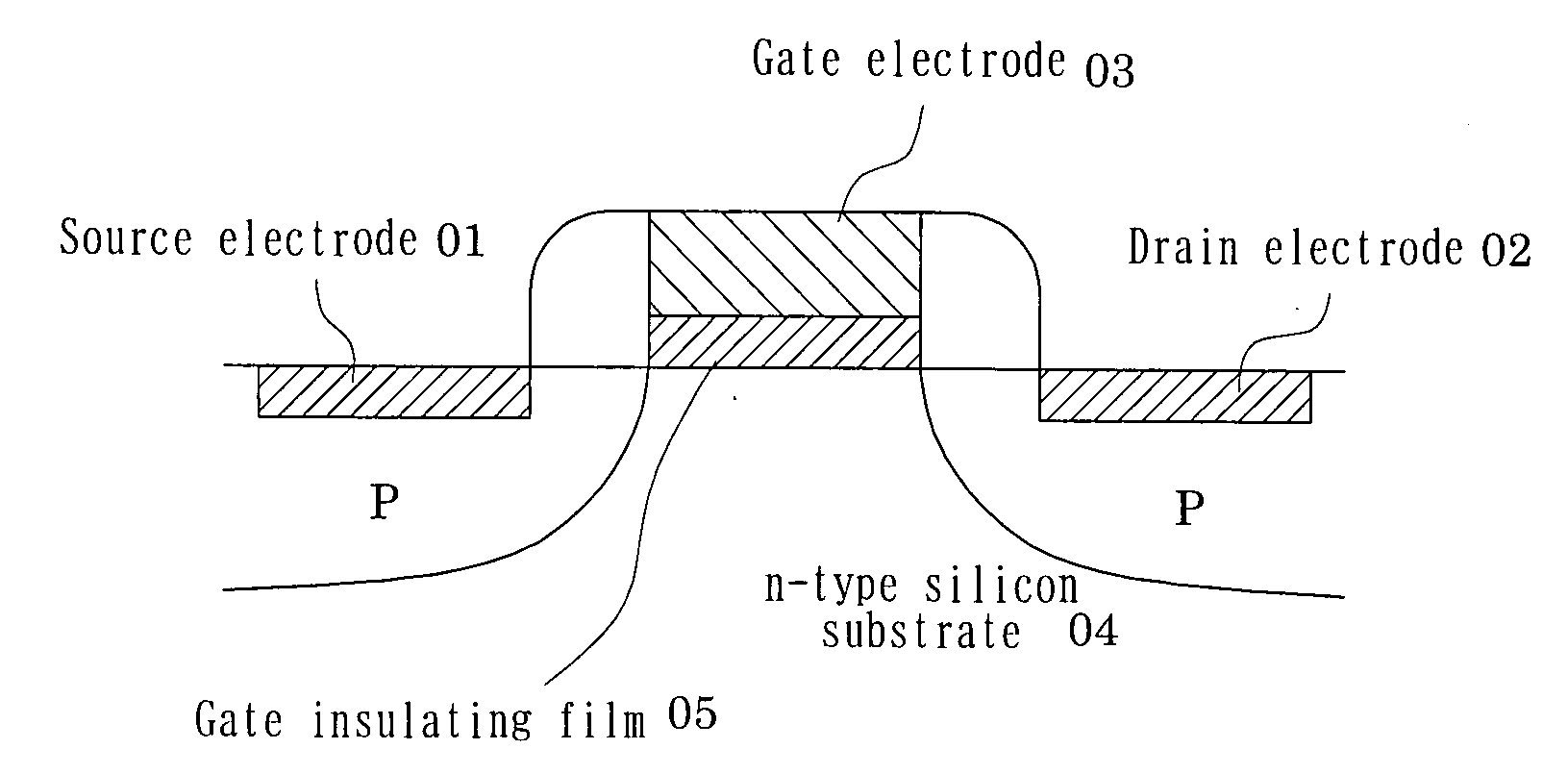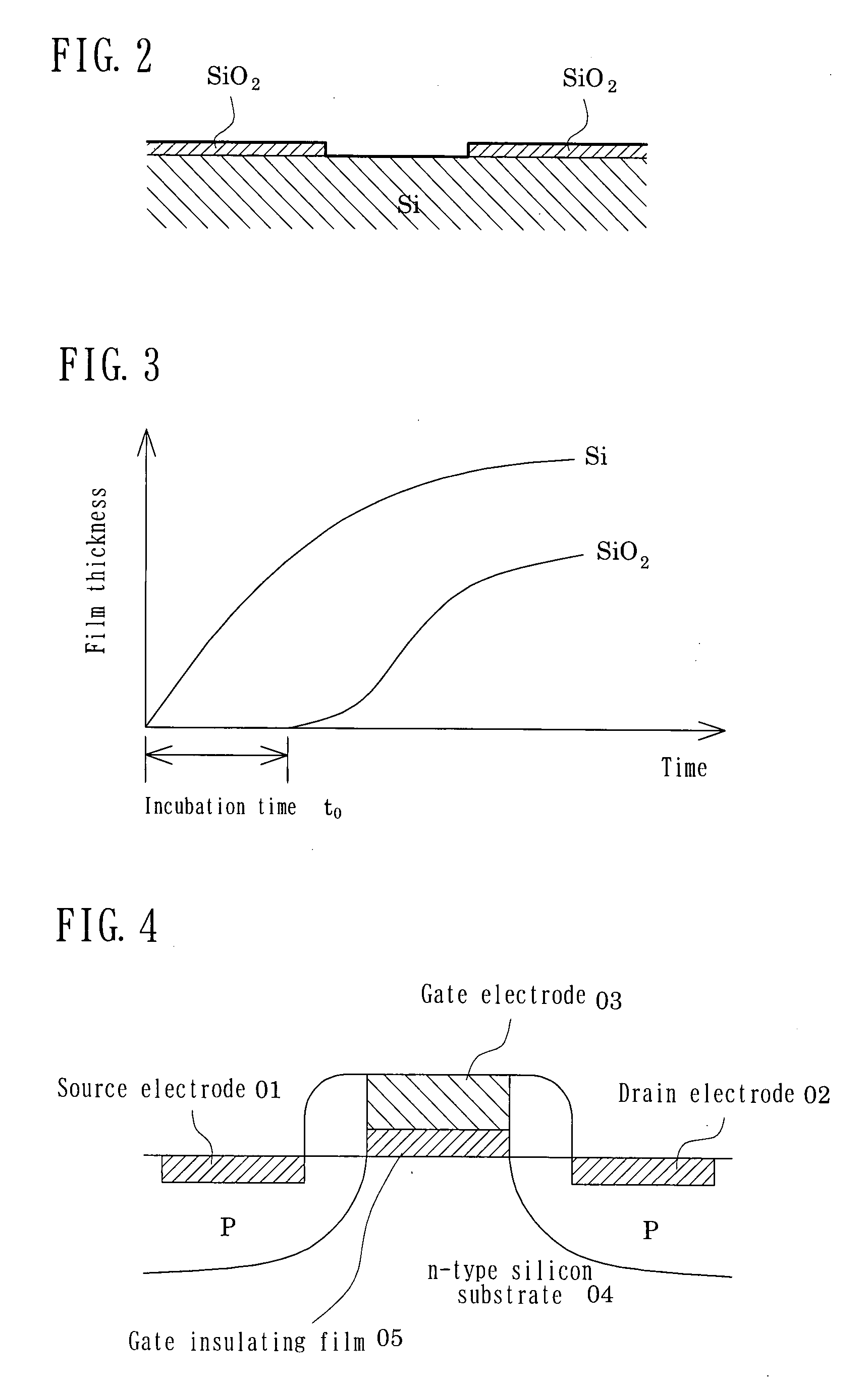Process for producing silicon compound
a technology of silicon compound and process, applied in the direction of metal silicide, vacuum evaporation coating, coating, etc., can solve the problems of large number of steps, and defect in device manufacturing, so as to achieve easy and efficient formation, free from deterioration, and the effect of efficient production of the compound
- Summary
- Abstract
- Description
- Claims
- Application Information
AI Technical Summary
Benefits of technology
Problems solved by technology
Method used
Image
Examples
first example
[0057]This example is an example in which NiSi is produced as the source electrode 01 and the drain electrode 02 of the MOS transistor shown in FIG. 4. The substrate 3 in this case is in a state in which a SiO2 film is formed on a Si substrate, and the SiO2 film at sites where the source electrode 01 and the drain electrode 02 are to be formed is removed, with the Si interface being exposed at these sites. The substrate 3 of such a configuration is placed on the support base 2 within the chamber 1 of the apparatus shown in FIG. 1. At this time, the member 11 to be etched is formed of Ni.
[0058]Using such an apparatus, the Cl2 gas 21 is supplied to the interior of the chamber 1 through the nozzles 14, and a high frequency electromagnetic wave is thrown by the plasma antenna 8 into the chamber 1. By so doing, the Cl2 gas 21 is ionized to generate the Cl2 gas plasma 23 and generate Cl radicals. As a result, the following reactions are caused within the chamber 1, whereby the source elec...
second example
[0068]This example is an example in which the gate electrode 03 of the MOS transistor shown in FIG. 4 is formed. The substrate 3 in this case is in a state in which a Si interface, such as polysilicon for formation of the gate electrode 03, is exposed. This substrate 3 is placed on the support base 2 within the chamber 1 of the apparatus shown in FIG. 1. At this time, the member 11 to be etched is formed of Ni.
[0069]Using such an apparatus, the Cl2 gas 21 is supplied to the interior of the chamber 1 through the nozzles 14, and a high frequency electromagnetic wave is thrown by the plasma antenna 8 into the chamber 1. By so doing, the Cl2 gas 21 is ionized to generate the Cl2 gas plasma 23 and generate Cl radicals. As a result, the following reactions are caused within the chamber 1, whereby the gate electrode 03 comprising a NiSi film at the Si interface can be formed.
third example
[0070]This example is an example in which the gate stack of the MOS transistor shown in FIG. 4 is formed. The SiO2 film which is the gate insulating film 05 is formed on the n-type silicon substrate 04 as the substrate 3 in this case. A Ni film is formed on the gate insulating film 05 by the same method as in the above examples. By this measure, a part of the Si component of SiO2 reacts with Ni to form a NiSi film as the gate electrode 03.
PUM
| Property | Measurement | Unit |
|---|---|---|
| temperature | aaaaa | aaaaa |
| temperature | aaaaa | aaaaa |
| incubation time | aaaaa | aaaaa |
Abstract
Description
Claims
Application Information
 Login to View More
Login to View More - R&D
- Intellectual Property
- Life Sciences
- Materials
- Tech Scout
- Unparalleled Data Quality
- Higher Quality Content
- 60% Fewer Hallucinations
Browse by: Latest US Patents, China's latest patents, Technical Efficacy Thesaurus, Application Domain, Technology Topic, Popular Technical Reports.
© 2025 PatSnap. All rights reserved.Legal|Privacy policy|Modern Slavery Act Transparency Statement|Sitemap|About US| Contact US: help@patsnap.com



